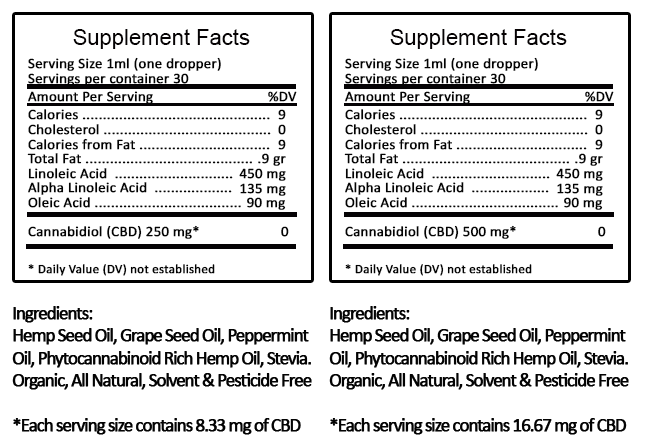The Reasons for Taking CBD Products
CBD has such a wide range of potential health benefits, that the reasons for taking it can vary wildly between users. One person may simply take CBD for general health, while another uses it to improve the quality of their sleep, while another uses it to keep mitigate MS symptoms. Understanding the reason for taking the substance is a first important step to deciding your correct dosage.
Understanding the Factors at Play
There are a number of factors at play that we need to to be considered for proper dosing. These factors will all have an impact on the CBD dosage that you decide on. Because of that, it's important to read over these and have some awareness about them as you work to find the right dosage for you and your patients.
Everyone's Physiological Makeup is Different
Everyone's physical makeup differs just as each person's endocannabinoid system is different. How CBD interacts with that system is different. The following factors need to be considered when finding your ideal dosage:
- Tolerance - general sensitivity to cannabis or other substances/medications/supplements.
- Weight - heavier people tend to require more CBD per dose.
- Metabolism - faster may require more CBD per dose.
- Diet - the junkier the diet, the more CBD may be required than in more balanced diets
Type of Product, Method of Application & Bioavailability
CBD products are grouped into categories based on 5 main ingestion/delivery methods.
- Oral - gel caps, edibles
- Sublingual - oils, tinctures, sprays - most common application
- Inhalation - vape, smoke
- Topical - lotions, balms, patches
- Suppositories - Anal, vaginal - least common
Each of these methods varies in bioavailability, the amount of time for the product to take effect, and the duration of the effect. By understanding the type of product you're getting, how it will be ingested, and the level of bioavailability you can adjust your estimated dosages.
| Method of Ingestion | Bioavailability | Onset | Duration |
| Oral Oils/Isolates (Capsules, Edibles) | Lowest | 30-90 Minutes | Up to 7 Hours |
| Sublingual (Oil Tinctures)* | Low-Mid | 20-40 Minutes | Up to 6 Hours |
| Inhalation (Vape, Smoke) | Mid-High | 2-5 Minutes | Up to 3 Hours |
| Topical (Lotions, Balms, Patches) | Low | 60-90 Minutes | Up to 6 Hours |
| Suppositories (Anal, Vaginal) | Highest | 10-15 Minutes | Up to 8 Hours |
*Note: Recent studies show that the bioavailability of sublingual tinctures can be improve by as much as four times when taken with food.
The Biphasic Effect
The compounds in cannabis display biphasic properties. This means that the effects at low and high doses can potentially display opposite effect. Since CBD can produce a wide range of benefits even at a low dose, there is even more reason to start with a low dose first. Because CBD has been shown to hold minimal side effects even at high doses, it may even be safe to try higher doses as well.
CBD Dosage Guidelines
- Mild to chronic pain and inflammation has been shown to be treated effectively in the 2-20mg CBD per day range.
- Chronic sleep disorders have been shown to be treated with 40-160mg daily.
- Epilepsy can require 600mg of CBD per day.
- Anxiety disorders can take as much as 300-600mg.(Note: many high dose rates are quoted from studies where the goal is to create a specific desired reaction within a very narrow time frame, i.e., 10 to 90 minutes.) Most anxiety cases are mitigated in the 25 to 50mg per day considering any medication(s) prescribed by their general practitioner, psychiatrist or neurologist. General anxiety, start low - under 10mg per occurrence then add more if needed.
- Many conditions most practitioners will treat can be mitigated successfully in the 15 to 40 mg range per day by up-titrating properly or adding a topical to the regimen as in cases of MS, OA and RA. As you up-titrate, take note of this as a target range. These ranges are easily determined when the dose/serving is displayed on the Supplement Facts label (see figure at right). If your label DOES NOT have this information, do not buy it.
Recommendations That Accompany Our VitalSYS Products for our Patients
We provide the following dosing information with our tinctures
- Serving Size 1 dropper (1mL). Take one to two times daily. Place under the tongue, hold for 60 seconds before swallowing.
- Take morning or night. Spread through out the day if possible. It helps to take with food.
- 250 mg tincture – start with ½ a dropper once a day for the first three days then increase by ½ dropper every three days until conditions improve, then maintain that level. If you've reached 16mg per day (two full droppers) and not yet reached the desired outcome, consider moving up to the 500mg tincture and start with 1 1/3mg per day (1 1/3rd dropper). Continue the process of walking your dosage up by 1/3mg (1/3dropper) once every three days.
- 500 mg tincture – start with half a dropper once a day for the first three days then increase to 1/2 dropper twice daily. Increase by ½ a dropper every three days until conditions improve then maintain.
IMPORTANT
Always start low and go slow to the level you find effective. Cannabinoids are generally well tolerated so you can confidently experiment with your patients dosages. Your greatest risk is reverse cascading from overdoing the dosing, which neutralizes the effect of taking the CBD. Always caution on the low side. You may be surprised to find how little CBD you actually need for the relief you're looking for.
How to Find the Beginning Oral CBD Dosage
Even though a patient may begin at the higher range, they should follow directions to walk the dosing up slowly as noted above. The following table will help you find a good starting place:
| Male and Female | Consideration | Beginning Range |
| Weight | overweight | 500mg |
| closer to ideal weight | 250mg | |
| Condition | mild to moderate | 250mg |
| severe/chronic | 500mg | |
| Metabolism/Sensitivity | highly sensitive | 250mg |
| low to moderate sensitivity | 500mg |
These general guidelines can be applied by anyone to work their way up to an ideal CBD dose. Be aware that as of January 1, 2020, there is a notable shortage of processors and growers in the US. This has caused a influx of imports from China and Europe where there is a lack of reliable documentation accompanying the raw materials.
- Use quality products. Although they're hard to source, practitioners should recommend only pharmaceutical grade CBD. Pharmaceutical grade hemp undergoes rigid manufacturing standards and quality controls set by the FDA. They will also have the the full compliment of CBD compounds and terpenes (PCR - phytocannabinoid rich) to provide the ultimate entourage effect. Avoid isolates.
- Understand the cannabinoid ratios and contents of your CBD oil. Oils generally contain other components like an MCT oil carrier and maybe some flavor like peppermint in an essential oil. The CBD content is expressed as a number of milligrams per bottle - usually 30 to 60 ml). More importantly is the amount of CBD per dose/serving, i.e. 8.33ml, 16.67, etc. You will find tinctures available anywhere from 100mg to 2500mg per 30ml bottle ranging from $35 to $250 at retail. As mentioned above, most conditions you will treat will be in the 500mg range (30ml bottle). With our VitaSYS branded tinctures this
 will provide 16.67mg of CBD per ML (see Supplement Facts label - right). You can easily see that you can get into the 30 to 40ml range per day pretty quickly and economically.
will provide 16.67mg of CBD per ML (see Supplement Facts label - right). You can easily see that you can get into the 30 to 40ml range per day pretty quickly and economically. - Consider the factors & estimate your dosage. Using the factors mentioned above and any independent research you may need to do for any condition, estimate your ideal dosage. For example, you may start a large man at a greater dose and higher concentration than a small woman. You're always safe starting low.
- Begin taking CBD at a low dose - Start low and go slow. Starting well below your target dosage and slowly increase 1/2 ml about every three to five days until you reach the desired effect. Most patients will never need to buy more than a 500ml concentration (30ml bottle). In such cases where you may need a larger dose, we suggest moving to a water-soluble nano-emulsion in a soft gel. There is a separate discussion on the bioavailability of nano-emulsions available - contact us directly.
- Spread out your doses. Rather than one dose all at once, spread them out over the course of a day.
- Hold course. Continue with the same dosage for a few days and observe. Take note of how you feel.
- Adjust accordingly. Once you establish a baseline, adjust up or down as needed. Remember less is more in the world of CBD.
- Take with food. CBD tinctures are fat soluble oils administered sublingually. Food can increase your bioavailability by as much as double.
What happens when you dose too high?
In terms of an adverse event, not much because CBD is well tolerated. Having said that, should a patient be taking more than necessary, there is a risk of reverse cascading wherein there is a nullifying effect or no effect other than a waste of money and material/product.
Are there any interactions with prescription drugs?
There are some interactions with pharmaceuticals that should be noted. CBD is metabolized in the liver by the P450 enzyme. Any drug that is also metabolized by this enzyme presents the chance of higher blood levels of the drug when taken with CBD. For a comprehensive guide to potential drug interactions with CBD please click this link: Potential Drug Interactions
Call For Practitioners' Pricing and Product Descriptions - 405-839-7200 M-F, 10a-7p Central Time
Sources:
IntelliCBD
European Journal of Pharmacology
ECHO Connection
Project CBD
CBD can be instrumental in mitigating a host of mild to chronic conditions so it's important that licensed health practitioners help steer the patient in the right direction. This is especially important for those with a history of alcohol or drug abuse, mental illness, or are pregnant or breastfeeding.
